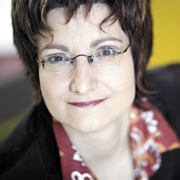Charlotte Seither has composed two works for the Niederrheinische Sinfoniker and the Dresdner Kammerchor which examine polyphonic linearity.
Like a staircase twisting in on itself in the pictures of MC Escher, the orchestral glissandi wind their way to the depths without ever allowing the range to sink – they are of course only of minimalist, abstract considered gestures. Following her composition Schatten und Klarsein. Verse für Heinrich von Kleist [Shadows and clarity. Verses for Heinrich von Kleist] for the Kleist Year 2011, Charlotte Seither has worked on formal processes in which, as she says, the processes are generated from themselves and form themselves into a horizontal line, “in the smallest steps with endless nuances and a strongly split up tableau of polyphony”. In her orchestral piece for the “Ensemblia Mönchengladbach Festival”, an occasionally haptic sonority of low, rasping parts is prominent – trombone glissandi, interferences from low bass clarinets – a naturalness which is powerful, astringent, but not loud, and which fully exploits the variable sound space of the middle orchestral scoring. It is in other words a construction, “which constantly sinks into itself”, a form of musical development which experiments with “flat formal models”: “What interests me is the radical quality of a form which is completely at a standstill in itself, and in which everything grows apart, without its architecture having to set down all too evident markers.”
Haut terrain for 12-part chamber choir was premiered by the Dresdner Kammerchor as part of the Dresdner Chorwerkstatt für Neue Musik in the Festspielhaus Hellerau, conducted by Hans-Christoph Rademann in February 2011. This also works with this utopian idea: a narrowly defined horizontal line for the choir, where the sung range is reduced to a limited compass in a high position, and leads the sonority to a “high terrain” as the title vividly proclaims. At the same time, according to Charlotte Seither, that sublime horizontal line means precisely a radical alternative approach to the choral texture: the high voices are fanned out many times in a kind of linear polyphony in which individual notes migrate through the individual parts and thereby demand the vocal art of the trained mezza-voce voices of the Renaissance. The male voices form a kind of noise-like counterpoint to the high voices with rhythmic interjections.
The result is an almost static, meditative sound web, which grates as a game of sound colours in microtonal realms. It is a kind of endless plaintive cry in an artistic language based on the Italian which evokes high choral art in abstract rhetorical models, as previously devised by Nono and Ligeti, and composes the inflection of speech of a touching, doleful eternally human.
Marie Luise Maintz
(Translation: Elizabeth Robinson)
from [t]akte 1/2011



